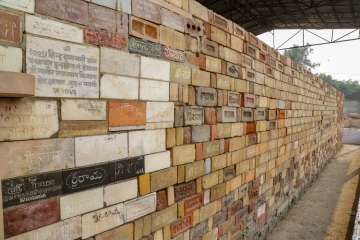The decades long contentious issue of Ayodhya Ram Mandir is being heard by the Supreme Court. A few organisations are trying to resolve the intriguing issue out the court too. While there is still no clarity over the matter, craftsmen at a workshop in Ayodhya are busy giving shape to huge rocks which will be used in the Ram Temple.
The work at Ram Janmabhomi Nyas-run workshop in Ayodhya's Karsevakpuram has been continuing since years.
The sprawling workshop also houses a wooden model of a 'proposed Ram Temple' in a glass encasement, many devotees stream in from various parts of India, some out of curiosity, other led by local tour guides.
Annu Bhai Sompura, in-charge of the workshop, points out to rows and rows of huge, ornately carved stones stacked up on the ground in the open in its premises, which he said are "ready-to-move blocks that can be easily assembled".
Carved stones are seen at the Ram Janmabhomi Nyas-run workshop at Karsevakpuram in Ayodhya. (Photo/PTI)
"Fifty per cent of carving work of stones has been completed, which means the first floor is ready. We are hopeful of getting a favourable judgement from the Supreme Court in the Ayodhya title suit, and once we get the green signal, the work on laying foundation would begin," he told PTI.
Ayodhya Ram Mandir: Design, size
As per the plan, the temple, once built, will be 268 ft long, 140 ft wide and 128 ft high, from the ground to the apex point (shikhar) and a total of 212 pillars will be used.
Each floor would have 106 pillars, and each pillar would have 16 statues.
A wooden model of the 'proposed Ram Temple' in a glass encasement, at the Ram Janmabhomi Nyas-run workshop at Karsevakpuram in Ayodhya. (Photo/PTI)
The work for prefabrication of a temple is currently being funded through "voluntary donations" from devotees.
The stones are carefully numbered and can be joined like a "jigsaw puzzle" using white cement when needed.
At the workshop, some of the pink sandstones which were carved intricately in the early 90s have darkened over the decades but these will be cleaned up once the time comes for their use, Sompura said, as he points towards lintels, and columns and ceiling blocks, bearing beautiful floral motifs.
A row of 'vedis' were created at one end of the workshop premises, using bricks bearing letters of 'Shri Ram' chants while carved white Makrana marble blocks lay inside an enclosure, gathering dust.
The workshop which operates from 7 am to 5 pm, has turned into a museum of sorts for devotees and inquisitve people alike, and over 1,000 people visit the 'karyashala' every day, he said, adding, many make it their next stop after visiting the heavily-fortified Ramjanmabhoomi site.
(With inputs from PTI)
Latest India News

